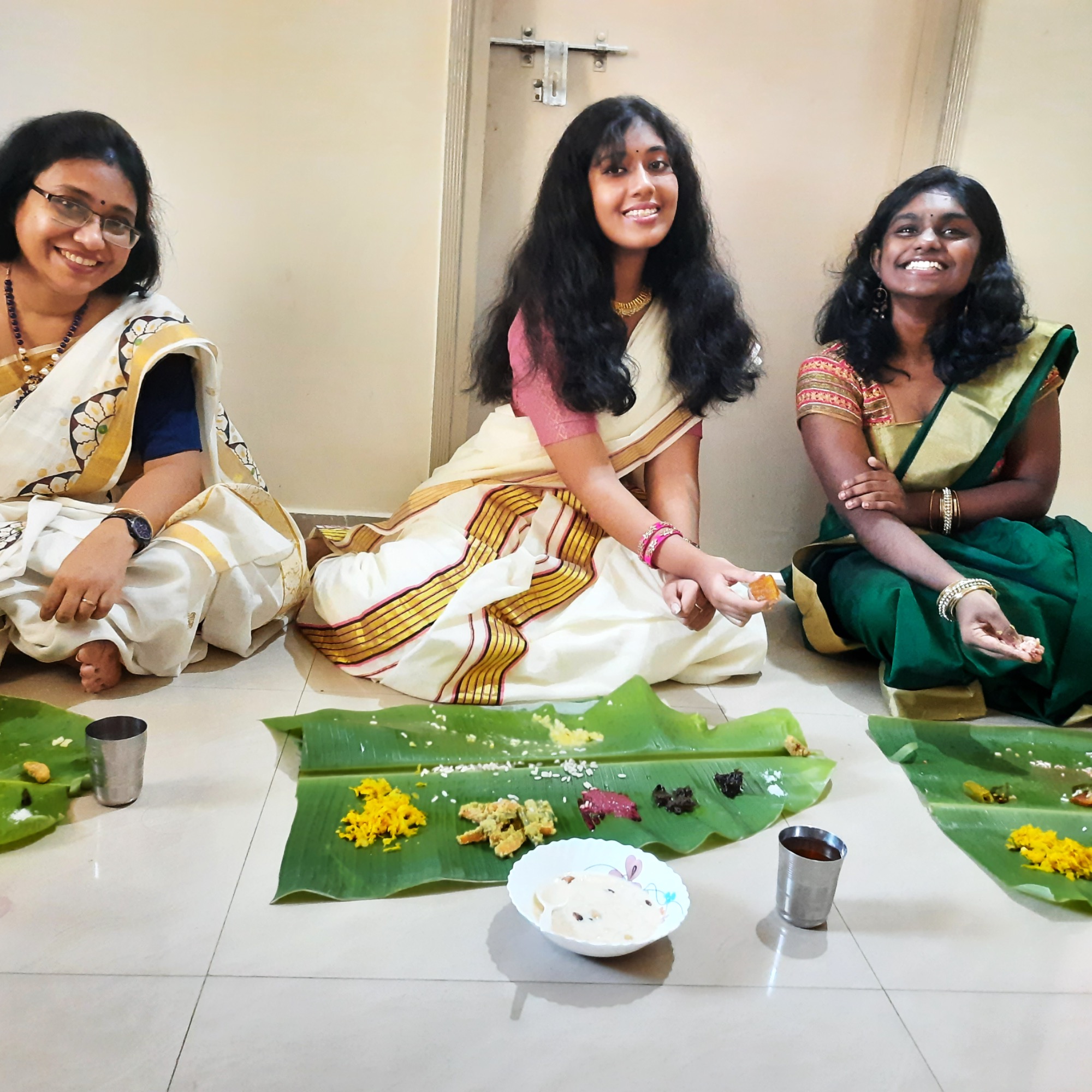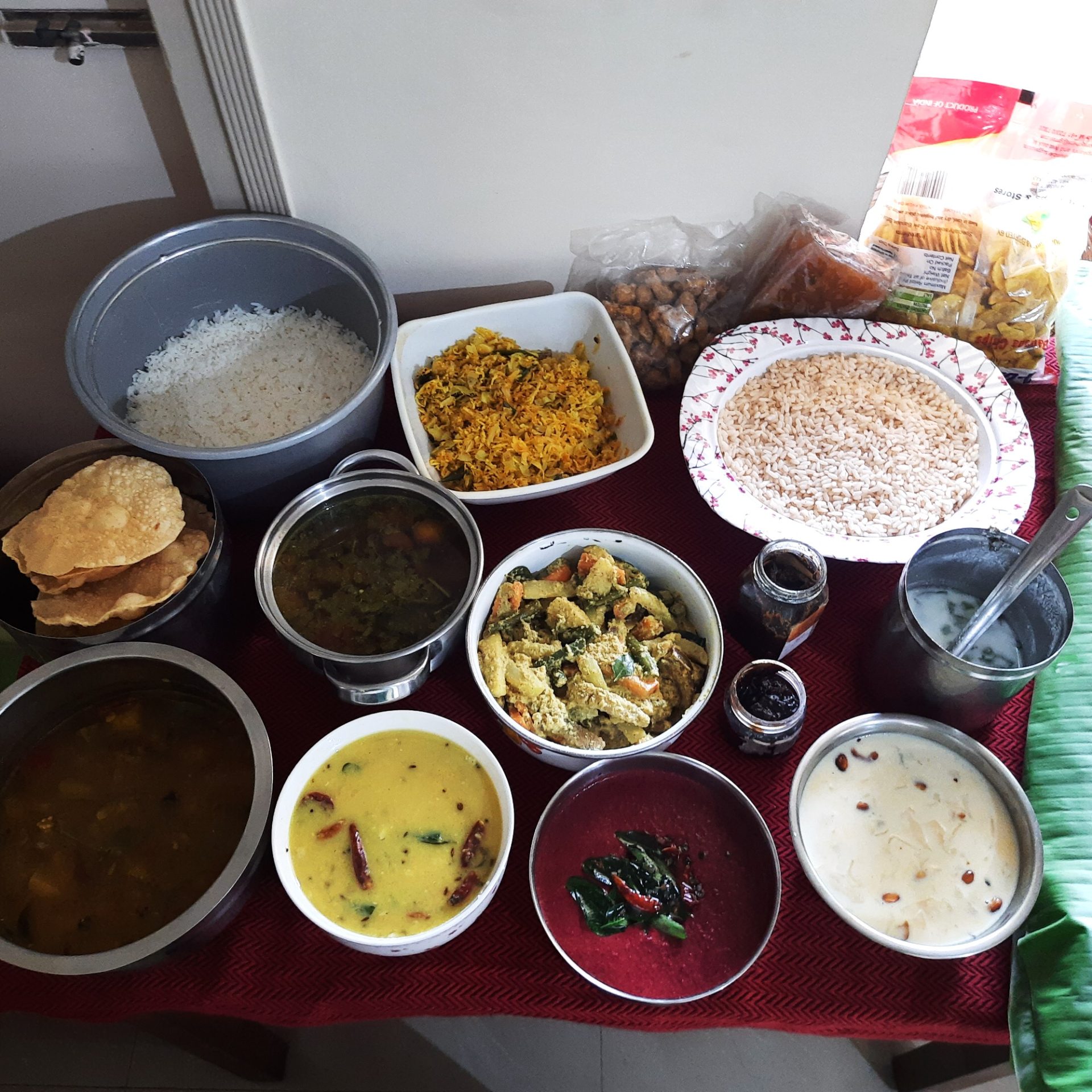The Grand Onam Feast
Onam Sadya, the lavish feast at the heart of Kerala’s Onam festival, is more than just a meal; it’s a vibrant celebration of heritage, community, and tradition that resonates with Malayalis across the globe. In this article, we dive into the deep-rooted history, diverse dishes, and cultural significance of the Onam Sadya, revealing why this cherished feast unites people beyond borders and generations.
From Kerala to the World: Embracing Onam’s Vibrant Spirit
Growing up in Kerala as a Tamilian, Onam was as integral to my identity as Pongal. I embraced both cultures, speaking both languages, and savouring both cuisines. When I moved to Ethiopia, I clung to home by preparing the traditional feast myself, inviting friends to experience Kerala’s vibrant culture, and the joy of eating on a banana leaf with their hands. This tradition followed me to Odisha, where my daughter and I crafted elaborate ‘Pookkalams’ (floral carpets) that became the selfie spot of our apartment. Every year, I’d prepare an elaborate Sadya feast, inviting friends who cherished Kerala’s rich flavours. Shopping for fresh vegetables and flowers was a joyful ritual, connecting me to Kerala no matter where I was. While each of Kerala’s fourteen districts celebrates Onam uniquely, Sadya remains the festival’s true highlight.
Unravelling the Festival’s Rich Heritage
Onam, Kerala’s most cherished festival, spans ten days in August or September. Onam is when Kerala eagerly awaits the homecoming of its most beloved king, Mahabali, filling homes with joy and anticipation. He was a demon king, who was sent to the netherworld by Vamana, the 5th avatar of Lord Vishnu but was granted permission to visit his people once a year. Onam also marks the end of the monsoon season and the beginning of the Malayalam New Year, Chingam. The festival features joyous family gatherings, festive feasts, and vibrant cultural events. Homes are decorated with intricate pookkalams, and communities enjoy traditional games, boat races, and Pulikali (tiger dances). The most auspicious day is Thiruvonam, when families come together to prepare and share the Sadya, a grand feast embodying the essence of Onam.

Onam Sadya: A Culinary Journey for the Senses
Onam Sadya, the traditional grand feast of Kerala, is more than just a meal; it’s a celebration of Kerala’s culinary diversity and cultural heritage, cherished by Malayalis worldwide. Typically served at lunch on a plantain leaf, this vegetarian feast includes parboiled red rice, various side dishes, savoury items, pickles, and desserts.
Onam Sadya brings together a range of flavours, embodying the six tastes: sweet, sour, salty, bitter, pungent, and astringent, creating a balanced experience on the palate.
Each dish has its place and purpose, with a specific order of eating rooted deeply in culture, blending tradition with science. The banana leaf not only enhances flavour and aroma but also offers health benefits. Did you know it has antibacterial properties, cooling effect and aids digestion? This is what makes the Sadya a unique experience, combining taste, tradition, and well-being – a feast for all the senses.
“Sell oilseeds if you have to; but make sure you savour Onam.”
This Malayalam proverb underscores the importance of the Onam Sadya and reflects how people go to great lengths to ensure Onam is celebrated with the utmost fervour and dedication.
The Art of Serving Sadya
According to the old-timers, a well-prepared Sadya is more than just delicious food; it’s an art form. Each dish should be served to the guest at just the right moment. Tradition dictates that the tapering end of the plantain leaf (Nakkila or Thoosanila) should point to the left of the seated guest. Every dish has its designated spot: dry dishes like papadum, salt and appetizers go on the left, pickles and chutneys in the top left, and rice in the center of the lower half. Side dishes like aviyal, thoran, and kalan are served from the center to the right. Curries are poured over the rice, adding depth of flavour. A banana, typically at the bottom left, provides a refreshing finish. This careful arrangement ensures a balanced meal and enhances the overall dining experience, reflecting the rich traditions of the Onam Sadya.
Sadya Essentials
Upperi: Deep-fried banana chips
Sarkkara Varatti: Jaggery Coated, fried Banana pieces
Papadum: Thin, crispy wafers of black gram flour.
Pickles: Tangy accompaniments made of mango, lemon or ginger.
Kichadi: Sautéed cucumber or ladies’ finger in curd with mustard, red chillies, and curry leaves (southern districts).
Pachadi: A sweet chutney made with pineapple, mango, or pumpkin.
Puli Inji: A rich, sweet and spicy chutney.
Kalan: A subtly spiced yoghurt-based curry made with yam or raw banana.
Olan: Light and flavourful vegetable stew of pumpkin and red grams simmered in a thin coconut milk gravy.
Erissery: Hearty lentil curry with yam and raw banana.
Koottukari: A mixed vegetable curry that includes yam, pumpkin and other veggies (a staple in central and northern Kerala).
Thoran: A stir-fry of finely chopped vegetables like string beans or cabbage, sautéed with grated coconut, red chillies, and turmeric
Aviyal: A medley of mixed vegetables in a coconut-based sauce, and green chillies, seasoned with fresh coconut oil and curry leaves right after cooking.
Payasam: A sweet, creamy pudding.
There’s a popular saying in Malayalam, “Savor the Sadya mindfully.”
This emphasizes being aware and appreciative of the different tastes and traditions associated with the feast —both in the way the dishes are served and in the order they are eaten.
Relishing Each Course
Eating a Sadya follows a particular sequence that’s believed to aid digestion. Once the rice and side dishes are served, the feast begins with Parippu, a liquid curry made from Toor dal, topped with a dollop of ghee. The second course features Sambhar, a hearty vegetable stew made with lentils, onions, chillies, coriander, turmeric, and a hint of asafoetida. Desserts come midway through the meal, starting with Payasam, a rich sweet dish made with brown molasses, coconut milk, and spices, garnished with cashews and raisins. Variations like Paalada Pradhaman, Parippu Pradhaman, or Semia Payasam may follow. Pazham, ripe banana, is usually enjoyed alongside the Payasams. In some places, it is customary to add Boli, a sweet flatbread made of channa dal and jaggery filling. After the desserts, rice is served again with Pulisseri, a seasoned buttermilk with turmeric and green chilies. This is followed by Rasam, a spicy mix of chili and peppercorns boiled in tamarind juice. The meal concludes with plain sour buttermilk, seasoned with green chilies, ginger, and salt.
A traditional Sadya is a feast that brings together an array of dishes—everything from stir-fries and curries to pickles. While the specific dishes and their preparation methods can vary across Kerala’s different regions, each Sadya reflects a blend of local tastes and traditions. Nowadays, with our fast-paced lifestyles, there’s been an increase in online and instant Sadya options.

A Feast Beyond Borders
Onam is more than a festival; it’s a celebration of Kerala’s rich cultural heritage and agrarian past, community spirit, and deep-rooted traditions. It brings people together, not just through grand feasts but through shared joy, unity, and the vibrant expression of a collective history. For Keralites, Onam is a way of life, a time to reconnect with their roots, savour the present, and carry forward a legacy of love and tradition. The grand Sadya feast, with its array of flavours and dishes, is just one of the many ways this festival brings people together, bridging the gap between the past and the present.


